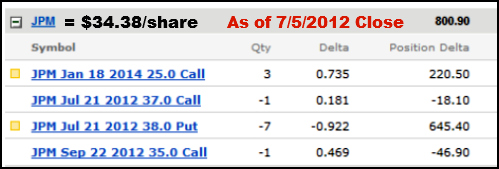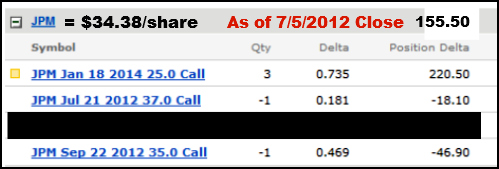Net Delta Position
What It Is and Why It's Important
If you're going to set up or work with option spread strategies, it's probably a good idea to be familiar with your trade's net delta position.
Delta Review
If you recall, delta is the option greek that measures the degree to which the price of an option will move in conjunction with the movement of the underlying stock's share price.
Or, in other words, if the stock moves up (or down) by a dollar, how much will the option move?
An option's delta can vary a great deal and it's impacted by a couple of different factors - its strike price (relative to the share price) and its expiration date.
Factor #1 - Strike Price
Essentially, the deeper in the money an option is, the greater its delta, which makes sense. Because the deeper in the money an option is, the less time value there is on the option and the more it should behave like the underlying stock.
Conversely, the farther out of the money an option is, the smaller its delta. If, for example, you own a $40 call on a $30 stock, and the shares move higher by a dollar, you certainly wouldn't expect the call option to increase by that same dollar. You'd probably be doing good if it moved higher by $0.20/contract.
And at the money options? They tend to be somewhere in between, moving perhaps $0.50/contract for every dollar move in the underlying stock.
Factor #2 - Expiration Date
The other factor is the expiration date.
The closer an option is to expiring, the more this in the money vs. out of the money dichotomy becomes more pronounced.
Again, this makes sense. That $40 call on the $30 stock? Suppose expiration is only a couple of days away. Even if the stock moves higher by $2-$3/share - there's still virtually no chance that the stock will expire anything other than worthless.
So it wouldn't make sense for price movement of the option to be in tandem with stock.
And the same thing can be seen with deep in the money options, where the value of the option is comprised mostly of intrinsic value. Suppose instead you owned a $30 call on a $40 stock and the stock moved higher by a buck.
With only a few days until expiration, you would expect that the value of the call would tend to mirror the movement of the stock a lot more closely than if you had a year or more remaining on the contract.
Does Delta Predict Price?
Finally, there's another way to look at delta which is technically incorrect. Still, in a weird sort of way, it may help you understand delta better.
Some traders view delta as the market's pricing in or predicting whether an option will close in the money.
For example, if you have an at the money call with a delta of 50 (meaning if the stock moves higher by a dollar, you can expect the option to increase by 50 cents), then some traders believe that Mr. Market is predicting there's basically a 50-50 chance that the stock will close at that strike price or higher.
Likewise, an in the money option with a delta of 70, so the theory goes, would have a 70% chance of finishing in the money. Or an out of the money option with a delta of 20 would only have a 20% chance of finishing in the money.
As I stated earlier, however, this really isn't a particularly accurate predictor of a stock's future share price, but it does give a different perspective.
Net Delta Position
So what is a net delta position, or net delta value?
If you have an option spread trade, by definition you're going to have both short and long positions that, in some degree, offset one another. And that's true whether we're talking about debit spreads or credit spreads.
But since I personally work with credit spreads much more often than debit spreads, let's look at a current calendar spread position I have as an example of what your net delta position or value can tell you about your trade and your potential risks and rewards.

Now, to make things more confusing, I also have a separate in the money naked put position included (the 7 short puts @ the $38 strike expiring on 7/21/2012).
The actual calendar credit spread consists of 3 long JPM $25 calls expiring in January 2014 (these are LEAPS) and a couple of open short calls written against the LEAPS (similar to a covered call, but using the long LEAPS in lieu of actually owning the underlying shares).
The two near term short calls in question are 1 @ the $37 strike expiring in the July monthly cycle (16 days away at the time of this writing) and a second @ the $35 strike expiring in September.
(Don't worry about trying to follow the ins and outs of the trade - this snapshot was taken after some trading adjustments and rolls, etc.)
It may be a little messy, but the example is still illustrative of net delta and how that value impacts a position and a portfolio.
If we look at the entire position (including the 7 naked or short puts), we see that this is a pretty bullish trade.
Or rather, the trade will benefit most by seeing the stock rise. In fact, what the table above shows is that the total net delta value is 800.90 (the "Position Delta" is tallied above the last column rather than below it).
What that means is that if JPM were to rise by $1/share, I could expect the net value of my portfolio (at least the JPM options portion of it) to increase by $800.90. It works the other way, too - if the stock were to fall by $1/share, I would expect the net value to decrease by approxmimately $800 as well.
That's obviously not a fixed number since the delta itself changes in value - earlier in the day, when I checked the net delta value, the number was lower, down in the $700s (and lucky me - JPM was down $1.50/share on the day I wrote this).
Gamma is the option greek that measures how much the delta itself will change for each $1 change in the underlying stock.
Net Delta's Impact on Calendar Spreads
It's also worthwhile to exclude the separate 7 naked puts position and just look at the LEAPS calendar spread (3 long dated calls and 2 corresponding short, near term calls) and see what the net delta there can tell us.

So if we exclude the 7 short puts' delta value of $645.40, the net delta value on just the calendar spread trade is 155.50.
That tells me that for every dollar the stock goes up (or down), I can expect the overall value of the trade to increase (or decrease) by roughly $150.
Although the inherent advantage of calendar spread trades is that you can exploit the different rates of time decay between longer term options (where the value erodes much more slowly) and that of near term options (where the time decay rates accelerate the closer you get to expiration), the trade as I've set it up, is still more or less a bullish trade.
I could have set up the trade to be more delta neutral, where moves in the underlying would have less impact on the value of my portfolio, and the profit in the trade would come more from the difference in theta (the rate of daily time decay) between the long and the short options.
The Flexibility and Trade Offs of Options
As I've said many times, options are always about trade offs.
Intuitively, you may understand that writing covered calls, whether you actually own the underlying shares or whether you own the LEAPS as a sort of proxy as I've done in this case, will limit your upside if the stock moves above your strike price.
But you can also see the numbers for yourself.
Case in point - we said that the net delta position on the JPM LEAPS calendar spread is 155.50. Now recall that I own 3 LEAPS in this example. So, in effect, if the stock trades higher by $1, the net increase in value of my LEAPS on an individual basis increases by a little more than $50 ($155 divided by 3), or roughly $0.50/contract.
Compare that to the straight delta on the 3 long LEAPS calls by themselves, which is 0.735, or 73.5 cents per each dollar move in the underlying. So the short calls very much act as a drag when the stock moves higher. But they also lessen the impact of moves lower.
And all the while, a zig here, a zag there, those near term options continue to lose more and more time value each day . . . which is the great lure of calendar spread trading in the first place.
Tweet
Follow @LeveragedInvest
HOME : Options Trading Education : Net Delta Position

>> The Complete Guide to Selling Puts (Best Put Selling Resource on the Web)
>> Constructing Multiple Lines of Defense Into Your Put Selling Trades (How to Safely Sell Options for High Yield Income in Any Market Environment)
Option Trading and Duration Series
Part 1 >> Best Durations When Buying or Selling Options (Updated Article)
Part 2 >> The Sweet Spot Expiration Date When Selling Options
Part 3 >> Pros and Cons of Selling Weekly Options
>> Comprehensive Guide to Selling Puts on Margin
Selling Puts and Earnings Series
>> Why Bear Markets Don't Matter When You Own a Great Business (Updated Article)
Part 1 >> Selling Puts Into Earnings
Part 2 >> How to Use Earnings to Manage and Repair a Short Put Trade
Part 3 >> Selling Puts and the Earnings Calendar (Weird but Important Tip)
Mastering the Psychology of the Stock Market Series
Part 1 >> Myth of Efficient Market Hypothesis
Part 2 >> Myth of Smart Money
Part 3 >> Psychology of Secular Bull and Bear Markets
Part 4 >> How to Know When a Stock Bubble is About to Pop



